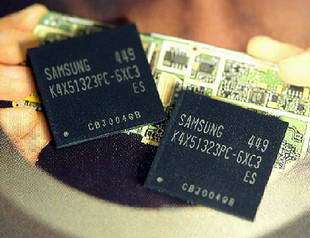Samsung Now Mass Producing First 90nm 512Mb Mobile DRAM

Samsung Electronics announced that it has started to mass produce 512Mb DRAM (dynamic random access memory) for mobile products, using 90nm circuitry. This marks the first time that 512Mb mobile DRAM will be available anywhere and the first time that nano-scale process technology will be used in the production of any mobile DRAM.
Mobile phones require high bandwidth for processing 3D graphics. Samsung's 512Mb mobile DRAM transmits data in a 32-bit stream and can process it at 1.3 GB per second, greatly improving the capability of a mobile product to accommodate richly textured images.
Samsung can also provide a one gigabyte memory capacity for mobile devices when two of its new 512Mb DRAMs are stacked together in a dual-die package, to meet anticipated short-term demand for additional mobile memory.
With the increasing demand of 3D graphic images on mobile phones and 5Mpixel and higher resolution camera phones, the overall data processing requirements on mobile handsets are exceeding 1GBs per second for data rate and 512Mb for density levels.
Moreover, mobile DRAM can provide up to a 50 percent reduction in power consumption over the conventional SDRAM.
According to Dataquest, the volume of mobile phones shipped worldwide will grow an average of 9% per year between 2005 and 2010. Demand for mobile DRAM will soar an average of 114% annually over the same period, indicating tremendous further growth in memory output over the next several years.
The new 512Mb mobile DRAM adds to Samsung's leadership in continuing to produce the most advanced next-generation memory technologies. For example, last month, the company developed the first GDDR4 (graphics double data rate 4 th generation) memory.
Source: Samsung


















